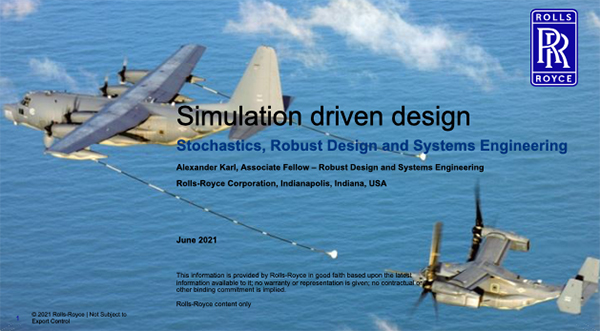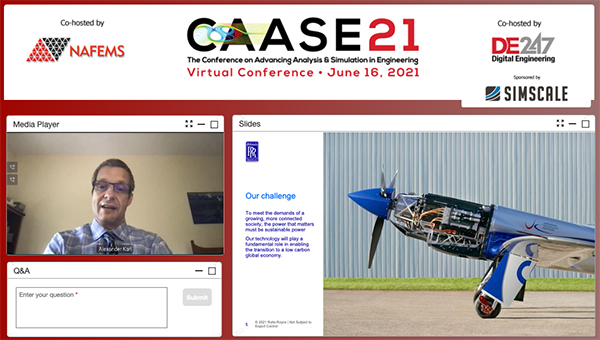CAASE21 Highlight: Nuts and Bolts of Simulation-Driven Design
Rolls-Royce Fellow tackles how robust design and systems engineering aid simulation-driven design in Track 1 of CAASE21.

Test bed in the UK. Image courtesy of Rolls-Royce.
Latest News
June 16, 2021
Simulation driven design with robust design can be applied successfully to help solve real-life business obstacles. That's the distilled takeaway from a presentation at the virtual CAASE21 by Alexander Karl, associate fellow, Robust Design and Systems Engineering, at Rolls-Royce in Indianapolis. He led CAASE21 Track 1: Stochastics, Robust Design and Systems Engineering to Support Simulation-Driven Design at the CAASE21 virtual conference on June 16, 2021. Kenneth Wong, senior editor of Digital Engineering, moderated his session.
He kicked off the session highlighting Rolls-Royce as a business entity and its present-day challenges, then delved into simulation-driven design and systems engineering, as well as stochastics and robust design tools and applications. The presentation closed with challenges and addressed submitted questions.

Karl says one of the challenges Rolls-Royce, a company of 48,000 people globally across 45 countries, is faced with at present is that in order to meet the demands of a growing, more connected society, “the power that matters must be sustainable power. Our technology will play a fundamental role in enabling the transition to a low carbon global economy.” Rolls-Royce has three core businesses, according to Karl: civil (which makes up about 50% of business; power systems (18%); and defense (20%).
Simulation-Driven Design and Systems Engineering
Diving into simulation driven design, Karl started with what he referred to as a “backbone” of structured hierchical models. “These models are necessary because most of the physical simulations today cannot address all of the physics in their given timeframes,” Karl explains.
The models, according to Karl, start with the SySML model, followed by the Physical System Model, then 1D, 2D, and 3D simulation models. All these models require test data, manufacturing data and service data. And all models are built with design and analysis knowledge.
As he explains it, “Simulation Driven Design is actually an extension of the classical Systems Engineering V.” He says this type of design is built with design models that are typically simplified models used to determine the product design. These models are grounded with sophisticated analysis models before real-world data is available. All these models are grounded in experiments via the Verification, Validation, and Uncertainty Quantification process.

Spirit of Innovation fully electric aircraft. The goal, according to Alexander Karl of Rolls-Royce, is to try to break the speed record for electric planes in the next few months. This is happening in the UK. Image courtesy of Rolls-Royce.
Simulations are being built using the digital enterprise which comprises physical (design and verification) and digital (model and simulation) systems.
In speaking on digital twins, Karl notes two key points: there is a flow of data or information between a digital and physical asset and the digital twin is applied throughout the life of the asset.
Robust Design
As part of his talk, Karl also delved into robust design. He highlighted how to use various tools to understand design inputs. The first step, Karl explains, is to understand your inputs. He asks, “What is driving my design? What is influencing my outputs of the design? This requires cross-functional cooperation and teamwork.”
It's important, according to Karl, to talk to manufacturing, collect data, talk to operations and customers. Find out where the material is made.
Next in the process is to develop models for input uncertainties. Then you're ready to propagate and calculate any variation and then assess the risk. During his talk he showed examples of real-world applications of the content he presented.
In conclusion, Karl says, “Simulation driven design with robust design can be applied to real business problems. You can do these complex simulations for components. These simulations are delivering real business value.”
But the road ahead is not without challenges. To address the roadblocks, Karl says further research is needed in the following areas: a method for data analysis and processing, integrated analysis processes and methods, multidisciplinary analysis tools and methods. The ultimate goal, according to Karl, is to realize a more widespread application of simulation-driven design.
CAASE21 is co-hosted by NAFEMS and is sponsored by Dassault Systemes, SimScale and TotalCAE. You can access all of the CAASE21 content on-demand here.
Subscribe to our FREE magazine, FREE email newsletters or both!
Latest News
About the Author
Stephanie is the Associate Editor of Digital Engineering.
Follow DERelated Topics






